Macrolepiota phaeodisca Bellù
Phylum: Basidiomycota - Class: Agaricomycetes - Order: Agaricales - Family: Agaricaceae
Distribution - Taxonomic History - Etymology - Identification - Culinary Notes - Reference Sources
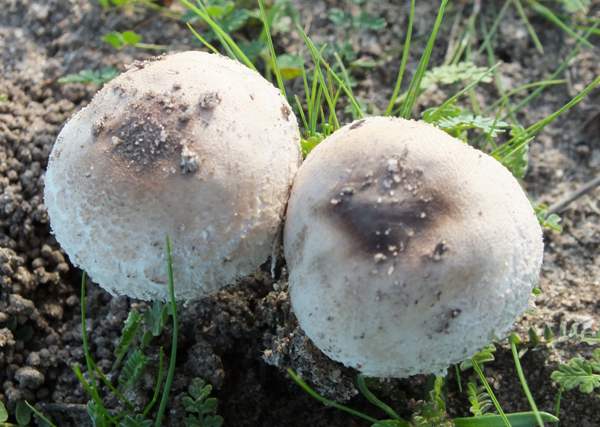
Macrolepiota phaeodisca is the smallest of the Macrolepiota parasol mushrooms and is found mainly in southern Europe.
Distribution
Not recorded in either Britain or Ireland, this species is quite common in central and southern France and in Italy, but it is widespread and abundant on the Iberian Peninsula, most particularly in sandy coastal regions of Portugal and Spain.
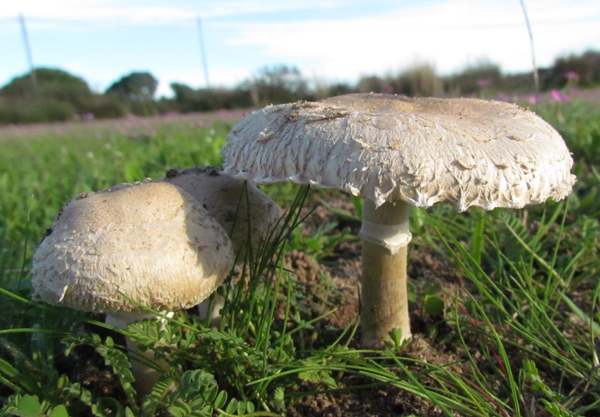
Shown above and on the left is a very fine specimen, one of several that I found in late February on sandy wasteland 5km inland from Carvoiero, in the Algarve region of Portugal.
Taxonomic history
This parasol mushroom was described in 1984 by the Italian naturalis Francisco Bellù, who gave it its currently-accepted binomial scientific name Macrolepiota phaeodisca.
I know of no synonyms of Macrolepiota phaeodisca; however, recent molecular studies by Else Vellinga have led some mycologists to suggest that Macrolepiota phaeodisca might be merely a colour form of Macrolepiota excoriata.
Etymology
The specific epithet phaeodisca means 'with a dusky disc' - a reference to the dark central area of the cap.
Identification guide
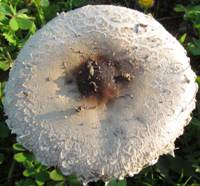 |
CapInitially convex and very pale brown with a darker brown area near the crown that breaks into scales, the cap of Macrolepiota phaeolepiota expends until it is flat with a small central bump, known as an umbo. The cap cuticle is floccose, covered with irregular concentric rings of flakes palest and most pronounced near the margin, and there are usually pallid saw-toothed flakes hanging from the rim. There is a dark brown (sometimes almost black) central disc. The cap diameter at maturity ranges between 4 and 8cm, and the flesh of the cap flesh is white and does not change colour significantly when cut.
|
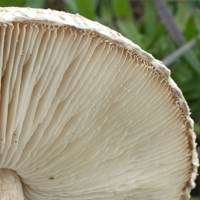 |
GillsThe broad, crowded gills of this mushroom are white or pale cream and free, terminating close to the stipe. |
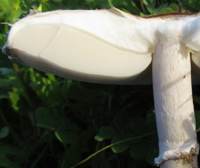 |
Stem and ringA single pendent ring persists around the stem of Macrolepiota phaeodisca; it does not become moveable on the stem. The stem is smooth and white or cream, and inside the stem the tough fibrous flesh is white.
|
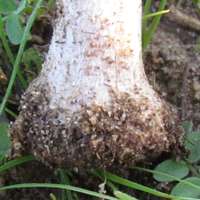 |
Bulbous at the base, the stem of Macrolepiota phaeodisca tapers inwards slightly towards the apex; the diameter ranges from 0.5 to 1cm (to 1.5cm across the bulbous base), and the stem height generally ranges between 6 and 12 cm. |
SporesEllipsoidal, smooth, thick-walled; typically 12 x 6 µm; with a small germ pore. Spore printWhite. |
|
Odour/taste |
Odour not distinctive; taste sweet. |
Habitat & Ecological role |
These pretty parasol mushrooms are saprobic. Macrolepiota phaeodisca is often seen in stable dune slacks near to the sea, but they can also be found in sandy pine plantations far from the coast and, occasionally, in meadows. |
Season |
Autumn in central Europe; October right through to March in the far south of Europe and in coastal parts of northern Africa. |
Similar species |
Chlorophyllum rhacodes, the Shaggy Parasol, is larger than Macrolepiota pphaeodisca and it has larger, reflexed scales. It is important to learn to distinguish between these two species, as for a large percentage of people the Shaggy Parasol is poisonous. Many of the smallish Lepiota (dapperling) mushrooms - for example Lepiota cristata - bear quite a close resemblance to Macrolepiota phaeodisca; some of them are seriously poisonous. |
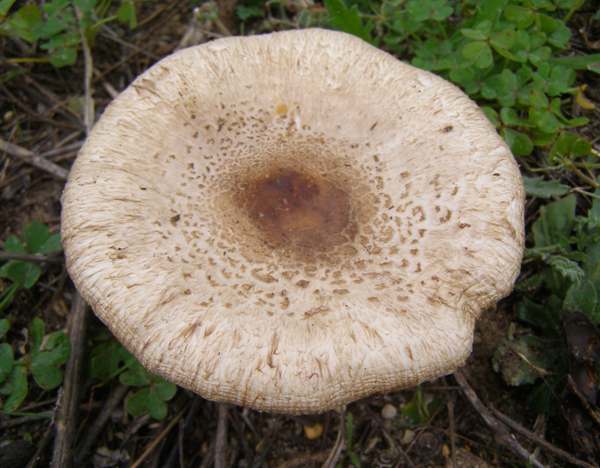
Culinary Notes
Several former members of the Macrolepiota genus are now sited in the genus Chlorophyllum, which contains parosal-like fungi known to be toxic to many people - for example Chlorophyllum rhacodes, the Shaggy Parasol. If you gather these tasty mushrooms to eat, be aware that the somewhat similar Shaggy Parasol, Chlorophyllum rhacodes, can cause tummy upsets. The Shaggy Parasol has flesh that turns red when it is cut
Parasol Schnitzel is my favourite when using this kind of mushroom in a meal. It fully deserves it place in the Magnificent Seven (seven fantastic free food fungi and how to cook them - see Fascinated by Fungi chapter 10.) If you are new to gathering wild mushrooms for the pot seek expert help; otherwise treat this and other small parasol mushrooms as suspect and do not gather them.
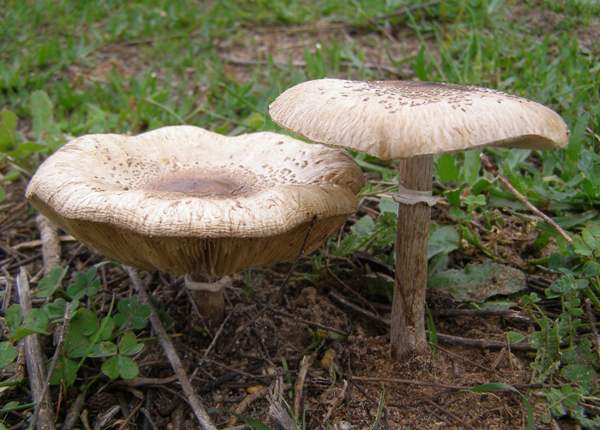
The second tip is more to do with quality. All fungi deteriorate in flavour and texture as the fruitbodies become old. (They may even become fly blown and maggoty.) So I recommend gathering edible prasol mushrooms at either the 'drumstick' or 'partly expanded umbrella' stages of development. By the time you get them home they will have expanded further, and the ideal time to pop them into the frying pan is when they have almost flattened out.
The cooking process will ensure that any mushrooms at the button or dromstick stage quickly expand to lie flat in the pan. (Of course, you will need to remove the stems, but don't discard them as they can be chopped up to make a perfectly acceptable mushroom soup provided you ensure that they are completely devoid of sand particles.)
Reference Sources
Fascinated by Fungi, 2nd Edition, Pat O'Reilly 2016, reprinted by Coch-y-bonddu Books in 2022.
Dictionary of the Fungi; Paul M. Kirk, Paul F. Cannon, David W. Minter and J. A. Stalpers; CABI, 2008
Taxonomic history and synonym information on these pages is drawn from many sources but in particular from the British Mycological Society's GB Checklist of Fungi.
Fascinated by Fungi. Back by popular demand, Pat O'Reilly's best-selling 450-page hardback book is available now. The latest second edition was republished with a sparkling new cover design in September 2022 by Coch-y-Bonddu Books. Full details and copies are available from the publisher's online bookshop...

